|
phase~LAB volcanoes, earthquakes and the hydrosphere through geodesy |
research
[ Real-Time/High-Rate GPS | Volcano Sources | Crustal Loading ]
This is an overview of my broad research interest and respective projects I have been working on over the last years (up to 2013). It is not exhaustive and I am always interested to apply some of the techniques described here to new problems, or learn something new to look at old data in a different way. If you're interested in collaboration, send me an email!
the lab - 2021 overview
Real-Time and high-rate GPS for Early Warning and Hazard Mitigation (top)
The work focusing on producing quality real-time GPS data for near instantaneous hazard assessment and mitigation is an emerging field. It benefits tremendously from high-rate (post-processed) GPS studies, as these identify worthwhile applications at a high signal to noise ratio. Major areas of research involve earthquake early warning and rapid response, eruption early warning and (near) real-time monitoring, and tsunami monitoring. The problems in real-time applications are rather technical as methods to reduce real-time noise must be developed, and strategies for handling and analyzing the resulting large volumes of data in minimum time need to be adapted.
Currently, in my post-doc work, I focus on the integration of real-time GPS into an existing seismic system for California. We want to enable reliable magnitude estimation for large events (M>6.5), and rapid estimation of distributed slip along a fault. I use simulated static offsets and real past events to test the system and estimate the timing of warnings / rapid response.
I have been also exploring the use of sub-daily GPS for volcanic plume detection at Redoubt and Okmok volcanoes. Below I show an example for Redoubt.
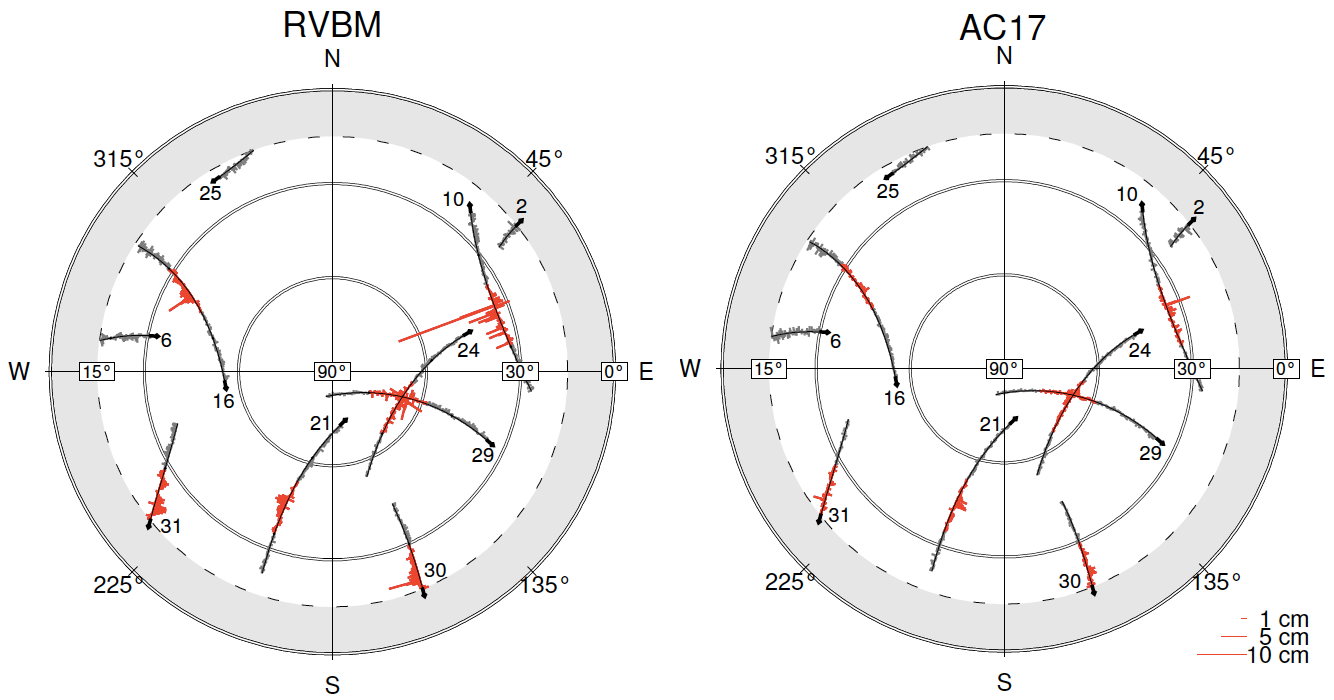
Relevant papers:
Volcanic Source Modeling (top)
Knowledge about the plumbing system of volcanoes is important for hazard assessments and our general understanding of how these land creators work. Geodetic data (InSAR, GPS, Leveling, Tilt, Gravity) are phenomenal tools to infer knowledge about the plumbing system of volcanoes. The results depend highly on the kind of volcano (open / closed system, magma compressibility, ...), depth of the source and its volume change. The expected pattern, however, is that of inflation of the edifice when the magma source is recharged and co-eruptive deflation; much like a ballon.

During my dissertation I was fortunate enough to conduct the first in-depth, GPS based geodetic studies of Redoubt Volcano in Alaska and Bezymianny Volcano in Kamchatka, Russia.
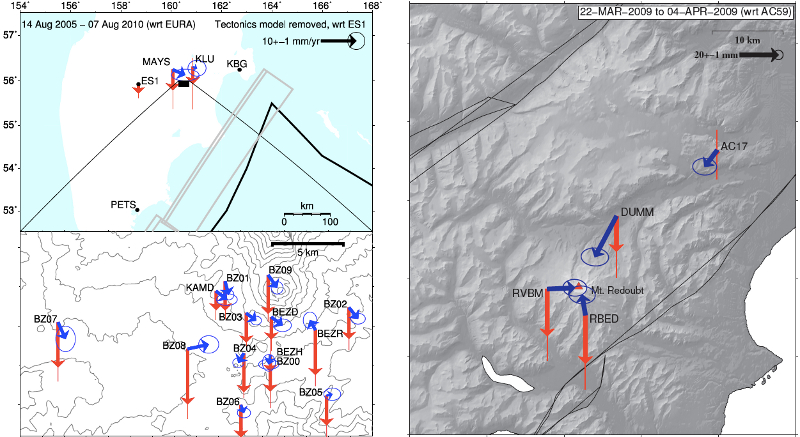
Right: Co-eruptive displacement field (not velocity!) at Redoubt showing displacements from March 22-April 4 2009 relative to a site about 100 km SW (horizontal: blue, vertical: red). Note the horizontals pointing to the vent indicating the map location of the deflation source (Grapenthin et al., JVGR, 2013b).
Redoubt erupted in 2009 and was equipped with a small monitoring network. We found an interesting aseismic pre-eruptive inflation period starting about 6 months before deep long period seismicity was recorded. This magma pooled underneath residual mush from the previous eruption in 1989/90. Heat and fluids percolating through this resulted in remobilization of the residual material. The entire GPS network subsided and moved inward toward the volcano from the summer of 2008 to summer of 2009 indicating that most of the material erupted was left over from the previous event.
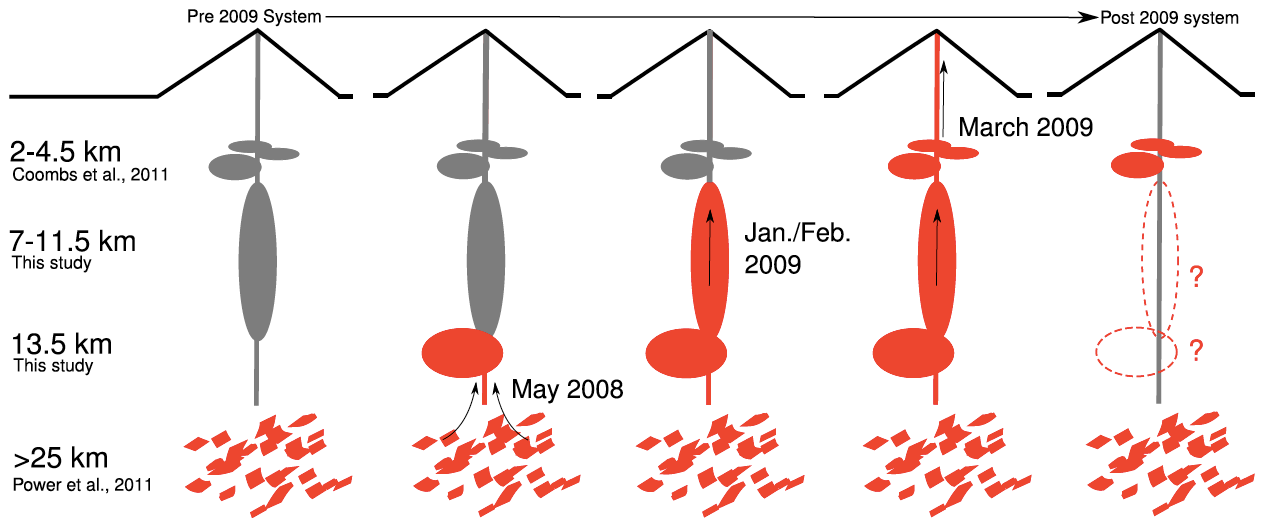
Over the 5 years of recording many small eruptions at Bezymianny we found only very small co-eruptive activity. The interesting observation here is, however, that the entire network subsides at rates up to 15 mm/yr. Neither subduction zone tectonics nor adjustment to volcanic loads seem to explain these observations. We infer that a a deep deflating sill beneath Klyuchevskoy at ~33 km depth can induce a signal very similar to what we record. However, to confirm this model, a much broader GPS network must be deployed. Bezymianny
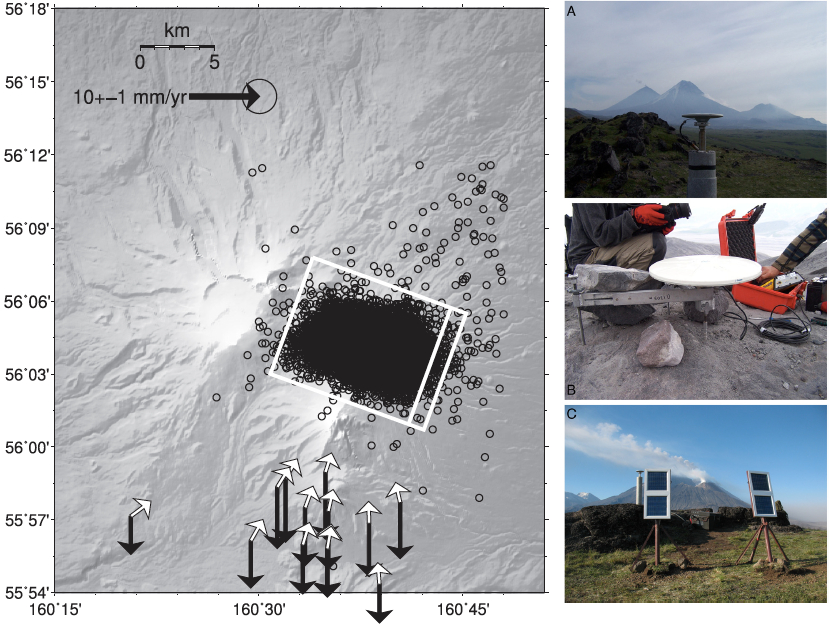
Right: (A) Continuous site BZ08 in summer of 2010. In the background: Kluchevskoy with a small ash plume to the left, Kamen in the middle, and Bezymianny to the right and degassing. (B) Campaign site BEZR with spike mount setup and Trimble NetRS receiver in 2010. (C) Continuous site BZ06 with solar setup installed in 2010. Bezymianny's dome steams in the background, which is the normal state. (Grapenthin et al., JVGR, 2013a).
Other studies, I was involved in focused, for example, on resolving a broad, dough-nut shaped, inflation pattern with central subsidence in InSAR data at Hekla volcano, Iceland. While we explained the inflation with a deep magma chamber and the central subsidence with adjustment to lava loading, other work suggests that a vertical cigar shaped model could induce the same pattern. Exciting stuff!
Relevant papers:
Crustal Loading Studies (top)
I have a great interest in how surface load dynamics affect the state of the crust and reveal details of the rheology of underlying materials, as well as how we can use crustal dynamics to reconstruct past loading histories.
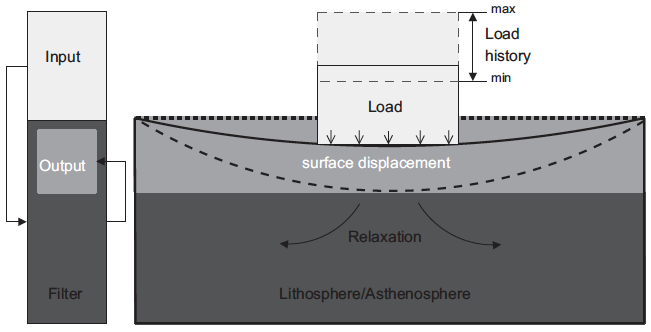
As a visiting student in Iceland I worked on seasonal variations in continuous GPS time series. We linked this signal to changes in snow load on Iceland's major ice caps (Grapenthin et al., 2006). To facilitate this work, I wrote software that simulates the crustal response to surface load changes. This code eventually turned into my diploma thesis in computer science (German M.Sc. equivalent) and has since been called CrusDe, and developed quite a bit further (Grapenthin, 2013). CrusDe's key capability is the implementation of an abstract relationship between Earth model and surface load, which enables an easy (plug-in based) exchange of problem specific model realizations. Some of my work uses CrusDe, for example, to address the bias surface loads (lava flows, glaciers) can introduce in magma source inversions at volcanoes (Grapenthin et al. 2010, 2013). I am currently working on including a spherical Earth geometry and, of course, applying it to exciting loading problems.

Right: Comparison of predicted and observed results of temporal modeling using a harmonic load at four CGPS stations: HOFN, SAUD, SKRO, and SOHO, in east, north and up component over the years 1999-2006. The detrended CGPS time series are shown by green dots. The red line is the best fit to the time series. The blue line is the modeled displacement using E = 40 GPa. Time series, best fit, and modeled displacement are relative to station REYK. (Grapenthin et al., GRL, 2006).
Relevant papers:
| Last modified: May 25 2023 16:19.